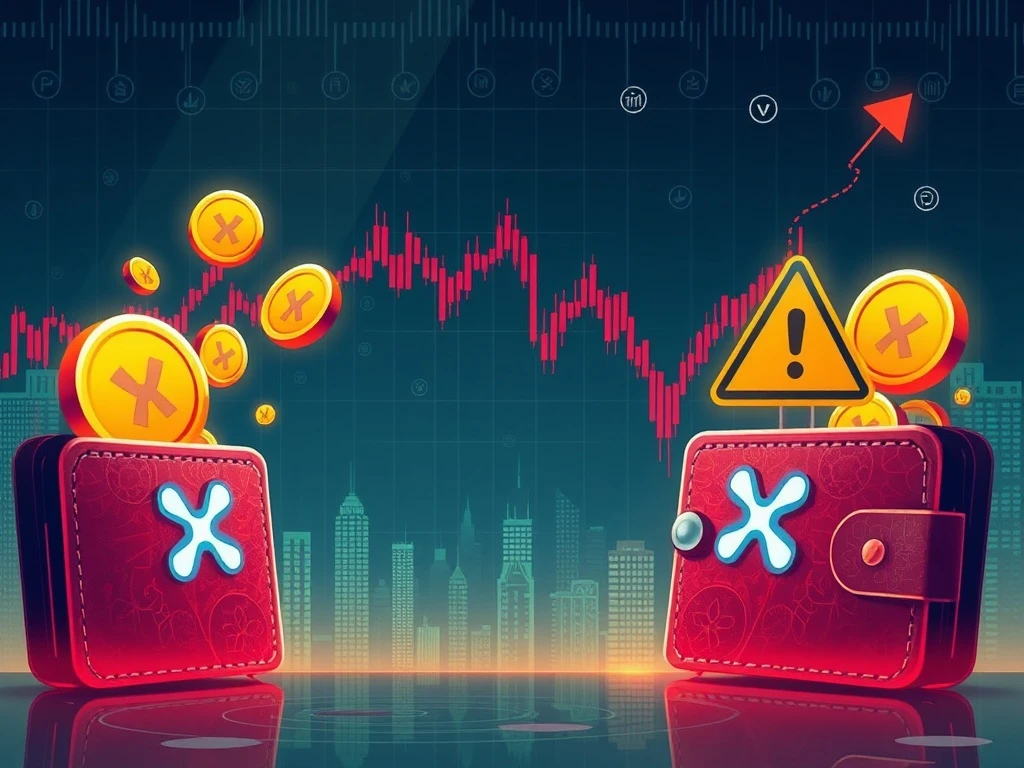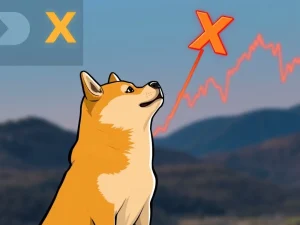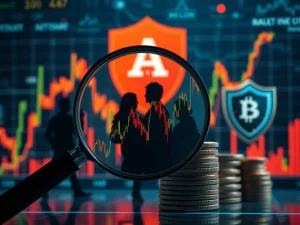XRP Under Siege: Ripple Co-Founder’s Massive Transfer Fuels Crypto Scams Amid Price Drop

Are you an XRP holder feeling the heat? The crypto world is abuzz with significant developments concerning XRP, as a massive transfer by Ripple co-founder Chris Larsen coincides with a concerning surge in crypto scams and a notable price correction. This confluence of events has sent ripples of concern through the community, prompting urgent warnings from Ripple executives. Understanding these dynamics is crucial for every investor navigating the volatile digital asset landscape.
XRP in the Spotlight: Unpacking Chris Larsen’s Massive Transfer
In a move that caught the attention of blockchain sleuths, Ripple co-founder Chris Larsen recently executed a substantial transfer of XRP tokens. On-chain data revealed that Larsen moved an astonishing 50 million XRP, valued at approximately $175 million, across multiple wallets between July 17 and July 23. This significant movement has naturally sparked questions and speculation within the XRP community.
- The Scale: 50 million XRP moved in a week, equating to $175 million.
- Destination Wallets: The funds were distributed to four addresses, with two later linked to crypto exchanges or third-party services. The remaining 10 million XRP was split into two new wallets.
- Larsen’s Holdings: Despite these substantial outflows, Larsen’s wallets still retain over 2.81 billion XRP, valued at more than $8.4 billion, underscoring his significant stake in the token.
Large transfers by prominent figures like Larsen can often signal various activities, from liquidity management to preparing for institutional transactions or even philanthropic endeavors. However, the timing of these transfers, amidst a volatile market and a surge in illicit activities, has intensified scrutiny.
The Alarming Rise of Crypto Scams Targeting the XRP Community
Perhaps the most pressing concern alongside Larsen’s transfers is the dramatic increase in crypto scams specifically targeting the XRP community. As XRP experienced a recent rally, fraudulent actors ramped up their efforts, preying on investor excitement and misinformation. Ripple executives have been quick to issue stern warnings:
- Ripple CEO Brad Garlinghouse’s Warning: He took to X (formerly Twitter) to alert users, stating, “Like clockwork, with success and market rallies, scammers ramp up their attacks on the crypto community—PLEASE BEWARE of the latest scam targeting the XRP family.”
- Common Scam Tactics: Garlinghouse referenced past incidents involving deepfake videos, fake airdrops, and phishing attempts designed to trick users into divulging wallet credentials or sending funds to fraudulent addresses.
- Ripple’s Official Stance: The company’s official X account reiterated a crucial message: “NEVER ask you to send us XRP.” They strongly advise against sharing wallet credentials or private keys.
The heightened transaction volume on the XRP network makes it a prime target for fraudsters. CoinRank data indicates a significant surge in scam reports linked to XRP in recent weeks, highlighting the ongoing challenge of securing digital assets in a rapidly evolving ecosystem.
Protecting Your XRP: Actionable Insights Against Scams
Given the alarming rise in scams, how can you safeguard your XRP and other digital assets? Vigilance and adherence to security best practices are paramount:
- Verify Sources: Always double-check the legitimacy of any communication claiming to be from Ripple or its executives. Official announcements are typically made on their verified channels.
- Beware of “Free Money” Offers: Legitimate projects rarely give away significant amounts of crypto for free. “Airdrops” or “giveaways” requiring you to send money first are almost always scams.
- Never Share Private Keys: Your private keys are the sole access to your funds. No legitimate entity will ever ask for them.
- Enable Multi-Factor Authentication (MFA): Use MFA on all your crypto exchanges and wallets for an added layer of security.
- Use Hardware Wallets: For significant holdings, consider storing your XRP on a hardware wallet for offline security.
- Report Suspicious Activity: If you encounter a scam, report it to the relevant platforms and authorities.
Understanding the Recent XRP Price Drop
The context for these developments is further shaped by the recent trajectory of the XRP price. After surging close to its all-time high of $3.40 in recent weeks, the token has experienced a retracement of over 12%. This correction aligns with broader market movements, as many cryptocurrencies have seen pullbacks following periods of significant gains.
Analysts suggest that large XRP movements, such as those executed by Chris Larsen, often correlate with liquidity management or institutional activity. However, the overlap with increased scam reports has raised questions about potential signals of market vulnerability or uncertainty. Investors are closely watching how the token stabilizes amidst these internal and external pressures.
Ripple’s Stance and the Broader Market Impact
Ripple, the company behind XRP, has consistently emphasized its commitment to fostering a secure and transparent ecosystem. Their swift warnings about the scam surge underscore this dedication. Beyond individual user security, Ripple also engages in ongoing collaboration with law enforcement agencies to dismantle fraudulent operations, highlighting a proactive approach to combating illicit activities.
The broader market impact of these events is multifaceted. The intertwining of large-scale token transfers, price volatility, and fraudulent schemes illustrates the inherent complexities of maintaining trust and stability in decentralized ecosystems. Regulatory uncertainties, particularly Ripple’s ongoing legal battles, continue to weigh on investor sentiment, adding another layer of complexity to XRP’s market dynamics. Investors are now balancing the potential for regulatory clarity against the immediate risks posed by scams and market corrections.
Navigating the Market with Chris Larsen’s Movements
The actions of influential figures like Chris Larsen inevitably draw attention and can influence market sentiment. While his recent transfers remain unexplained publicly, they serve as a reminder of the significant holdings concentrated among early adopters and founders. For investors, understanding these large movements means considering their potential implications, whether for market liquidity, strategic positioning, or simply as a normal part of asset management for high-net-worth individuals.
In a market characterized by rapid information flow, it is crucial for investors to avoid making impulsive decisions based solely on large transfers or FUD (fear, uncertainty, and doubt) generated by scam reports. Instead, a balanced approach that combines fundamental analysis, technical indicators, and robust security practices is essential for long-term success in the crypto space.
The recent developments surrounding XRP—Chris Larsen’s significant transfers, the surge in crypto scams, and the price correction—paint a vivid picture of the challenges and opportunities within the cryptocurrency market. While the movements of large holders can be intriguing, the paramount concern remains investor safety against increasingly sophisticated fraudulent schemes. By staying informed, practicing robust security measures, and approaching the market with a clear strategy, XRP holders can better navigate these turbulent waters and protect their investments. The interplay between asset movements and market dynamics underscores the need for continuous vigilance and education in the decentralized world.
Frequently Asked Questions (FAQs)
Q1: Why did Ripple co-founder Chris Larsen transfer such a large amount of XRP?
A1: The exact reasons for Chris Larsen’s $175 million XRP transfer have not been publicly disclosed. Large transfers by significant holders can be for various reasons, including liquidity management, preparing for institutional transactions, portfolio rebalancing, or even philanthropic activities. It’s a common practice for high-net-worth individuals to move assets between wallets for security or operational purposes.
Q2: How are crypto scams targeting XRP users specifically?
A2: Scammers often target popular cryptocurrencies like XRP due to their large communities and increased trading activity. Common tactics include impersonating Ripple executives or official accounts on social media, promoting fake “giveaways” or “airdrops” that require users to send XRP first, using deepfake videos to promote fraudulent schemes, and phishing attempts to steal wallet credentials.
Q3: What should I do if I encounter an XRP-related scam?
A3: If you encounter a scam, do not engage with it. Report the suspicious activity to the platform where you encountered it (e.g., social media, exchange). If you’ve already sent funds or shared information, immediately secure your accounts, change passwords, and consider reporting the incident to relevant law enforcement or cybersecurity authorities. Never share your private keys or seed phrase.
Q4: Is the recent XRP price drop related to Chris Larsen’s transfers or the scam surge?
A4: The 12% XRP price drop aligns with broader market corrections observed across many cryptocurrencies. While large transfers can sometimes influence market sentiment, and increased scam activity can create FUD (fear, uncertainty, doubt), it’s unlikely that these factors alone are the sole cause of the price drop. It’s more likely a combination of market-wide trends, profit-taking after a rally, and ongoing regulatory uncertainties.
Q5: How does Ripple combat these scams?
A5: Ripple actively combats scams by issuing public warnings through its official channels (like X), educating its community on security best practices, and reiterating that they will never ask users to send them XRP or share wallet credentials. They also collaborate with law enforcement agencies to track down and dismantle fraudulent operations, aiming to protect the integrity of the XRP ecosystem.








